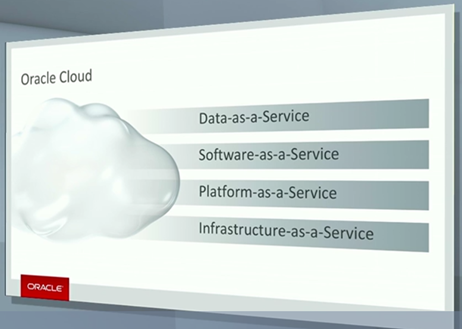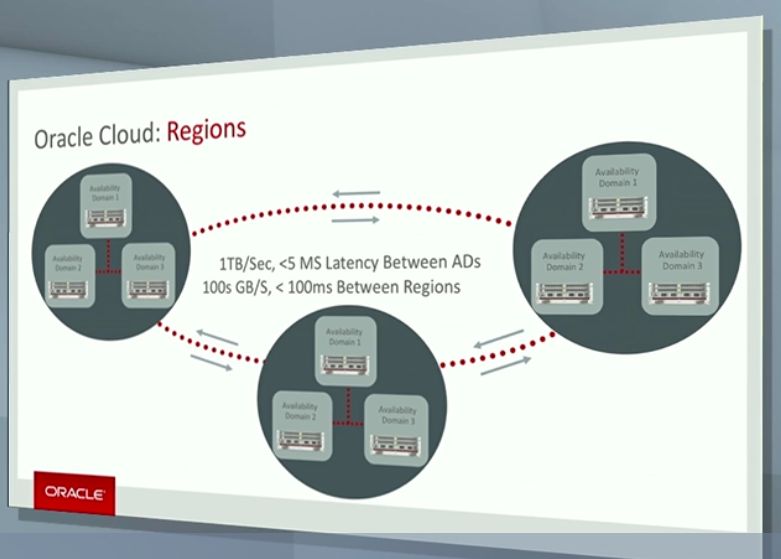Oracle OpenWorld 2016: fundamentally new features of IaaS, PaaS and SaaS services

The Oracle OpenWorld 2016 Annual Conference, held in September in San Francisco, is already the 20th in a row, gathered more than 60 thousand customers and partners from 141 countries of the world. As Mark Hurd said on the eve of the Oracle CEO Forum, “this year will be the second in a row when Oracle sells more SaaS and PaaS solutions than any other cloud provider.” New developments , demonstrated and announced at Oracle OpenWorld 2016, will be a good basis for strengthening the position of the corporation in the segment of infrastructure services - IaaS .
The corporation presented at the forum the second generation of its services Infrastructure as a Service (IaaS). According to Larry Ellison, Executive Chairman of the Board of Directors and SRT Oracle, “Generation2 IaaS solutions offer 2.5 times more processing power, twice the RAM, 4.5 times more storage capacity on SSD and 11.5 times better performance input-output (IOPS) is priced at 20% lower than Amazon Web Services. ”
The new version of DBMS Oracle Database 12c Release 2 helps to cope with the exponential growth of data due to faster analytical applications and support for large databases (up to hundreds of terabytes). By combining the optimized Oracle Exadata software and hardware systems with database technology, Oracle was able to offer an entry-level solution for industrial databases “from small to medium size”, as well as for development and testing - at a price of $ 175 per month as part of a service subscription Oracle Exadata Express Cloud Service. Replenished with new services and features and a family of solutions Oracle Big Data Cloud Services, as well as services for analytics in the cloud.
In his plenary report, Larry Ellison also shared the results of detailed analysis, which show that Oracle Database-as-a-Service (DBaaS) exceeds Amazon DBaaS in speed in analytical tasks up to 105 times, in OLTP tasks up to 35 times and more than 1000 times with mixed loads, and thanks to optimization, the Oracle Database runs in the Oracle Cloud up to 24 times faster than the Oracle Database in AWS.
')
Oracle Cloud Infrastructure - Reliability and Performance
According to Thomas Curian, Oracle's president of product development, infrastructure services assume the ability for a user to create Oracle-based users through a browser or API of their own virtual data center with modern cloud services — highly reliable and well-scalable, highly productive, secure, controlled and managed. The corporation pays special attention to these characteristics.

Oracle IaaS Generation2 is guaranteed reliability. Services can be deployed in a fault-tolerant configuration across three sites - the Availability Domain (AD). Three data centers are connected by channels with high bandwidth and low latency. AD unite in the so-called regions (Regions) - geographically distant domains. AD and regions are connected by high-speed channels: between AD - 1 TB / s with a delay of less than 5 ms, between regions - 100 GB / s with a delay not exceeding 100 ms. This configuration is designed for business-critical applications.

The data centers themselves use a modern network with a “flat” architecture, and the network and storage infrastructure is virtualized at the network level, and not at the hypervisor level. As a result, a high level of security and manageability is ensured.
Each compute node in the network can access another compute node or storage node. Host systems are connected by channels of 10 Gbit / s. Due to the absence of “oversubscription” over network and computing resources, predictable network bandwidth and performance are provided. The delay in transferring data between compute nodes and storage nodes on a data center scale is also predictable.

The Oracle data center infrastructure uses high-performance computing and storage nodes. I / O performance reaches 1 million IOPS, and in high-density configurations, 4 million IOPS.
Online cloud protection with enhanced authentication and analytics features
How does Oracle ensure the administration and security of its cloud? As Thomas Curian emphasized, to protect client information and applications, network traffic isolation is used (customer virtual environments are shared at the network and service levels), full encryption of customer data, centralized management of identifiers and keys using federated cloud and enterprise identifiers, strong authentication and strong separation of powers.
The new Oracle Identity Cloud Service cloud platform for security and authentication allows you to centrally manage user identities in the cloud and in traditional IT environments deployed directly in the enterprise.
The new Oracle Management Cloud package of cloud services for managing the lifecycle of enterprise applications includes the Oracle Security Monitoring and Analytics Cloud Service, which applies machine learning techniques to help identify security threats and provide early warning. It detects anomalies, helps to ensure specified performance, compliance with policies and security requirements. A comprehensive monitoring and control system also provides orchestration and change management functions.
The Oracle Management Cloud Service control panel (Dashboard) integrated with the resource consumption monitoring system provides the customer’s system administrator with a complete picture of information security events: shows application performance parameters (SLA), event logs, security compliance assessment, security events, incidents, etc. The new Cloud Access Security Broker tool allows the system administrators of the customer to monitor their users' access to cloud applications and services AM, configure and apply authorization rules.

To identify the causes of security incidents and eliminate them, the system administrator can detail the information, see the consequences of which incidents are resolved automatically and which are not.

Security Monitoring and Analytics Service helps you analyze incidents by tracking event chains and their interrelationships. It allows you to automate operations to prevent and eliminate threats, for example, automatically block a user with suspicious activity.

The administrator also has the ability to perform regular checks for compliance with security policies (Compliance Check).

In particular, it is possible to identify and correct software configuration problems. The administrator can see if the databases correspond to the given configuration, whether updates (patches) are applied. For example, if one of the databases has deviations in the configuration, it is immediately visible on the screen. The administrator can easily determine the cause and eliminate it by applying a patch or taking other measures. Change management is based on optimization rules (orchestration).

New analytical services reveal anomalies in behavior and analyze events, prevent threats. According to Larry Ellison, the purchase of Palerra by Oracle will ensure the highest level of security for cloud services. This will eliminate one of the most serious obstacles to their further implementation.
Application and data deployment models: new features
Oracle is the only vendor whose load can really be transferred between the customer’s site and the cloud. Oracle Cloud 2016 provides for further expansion of the application and database migration capabilities between the customer’s data center and the cloud.
Today, Oracle DBMS can be deployed at the customer as software at its facilities, as a service on a “cloud machine” (Oracle Exadata Database Machine, Oracle Infrastructure Cloud Machine, Oracle Big Data Cloud Machine), or in a cloud (Oracle Public Cloud, AWS, Azure ). At the same time, the coexistence of cloud and local applications / data and their migration between the cloud and the customer's site are ensured by “one click”. Amazon Redshift does not provide such features.
Cloud usage patterns are evolving. Previously, customers had two options: buying a software license and deploying it on their own facilities or subscribing to a service in the Oracle Cloud public cloud. Now a third opportunity has been added to them - Cloud @ Customer, the software deployment by the customer in the Oracle public cloud located on the customer’s territory behind its own firewall. Oracle will manage this service in the same way as a public cloud service. Such a managed service is offered by subscription model. In this case, since the same software and hardware are used at the customer’s site and in the Oracle cloud, applications and data can be transferred between them with one click.
At the core of the DBaaS service package is the new DBMS Oracle Database 12c Release 2 . This version, originally created for use in the cloud, is designed for any database workloads - from entry-level applications to enterprise-class workloads. All the capabilities provided by the Oracle database hosted in the customer data center can be used in a cloud environment.
Simplify the development and integration of applications and data in cloud and traditional environments
Improvements in the Oracle Cloud Platform cloud platform include a wide range of tools for various application development models, including 19 new PaaS services, including the Oracle Container Cloud Service, the Oracle Identity Cloud Service, the Oracle Internet of Things Cloud Service, the Big Data Cloud Services, and Oracle Analytics Cloud Services.
Developers can use the Oracle API Platform Cloud Service to create, protect, and manage APIs. He does not require programming. The API Gateway can be run in an Oracle Cloud environment, in local environments, or in the clouds of other providers. Managing cloud integration with traditional environments simplifies the Oracle Integration Cloud Service. It contains more than 50 built-in adapters for applications and also does not require programming.
Oracle Data Integration Cloud Service offers replication features and various options for moving data between Oracle PaaS services and third-party DBAaS services. Oracle Data Integration Cloud contains a unified design environment for transforming structured data, MapReduce and Hive. Using the Oracle Internet of Things Cloud Service, organizations can deploy ready-made Internet of Things (IoT) applications and integrate them with business applications.
Oracle Developer Cloud Service makes it easy to interact with developers by integrating with popular collaboration tools. Oracle Mobile Cloud Service also offers intelligent and contextual chat bots in various messaging channels.
With the new Oracle PaaS services, developers have even more freedom to choose where to develop - directly in the enterprise or in the cloud, using a variety of programming languages and services.
The path to digital transformation
A decade ago, Oracle launched a project that was destined to radically change the way it works with IT infrastructure and applications — they became available as cloud services.

Over the past 11 quarters, the number of Oracle Cloud customers has increased by 270%, and the number of transactions processed by Oracle Cloud has increased by 215% during this period. Today, Oracle Cloud Cloud serves 60 thousand organizations, more than 27 million users, processes 50 billion transactions daily. The corporation offers a wide range of SaaS services that can satisfy almost any need. This radically changes the way organizations work with IT infrastructure, platforms and applications, opens up opportunities for any company and organization in the world to transform business.
New Oracle released at a time when many organizations that want to take advantage of the cost-effectiveness and simplicity of the cloud have yet to make this transition. Concerns about security, the scale and complexity of the task, the uncertainty of migration paths, disparate toolkits and lack of experience have led many organizations to not be sufficiently active in finding a cloud solution with the functionality required for an IT infrastructure. Thanks to new announcements, Oracle can offer the capabilities that businesses need to take full advantage of the cloud.
Source: https://habr.com/ru/post/312012/
All Articles